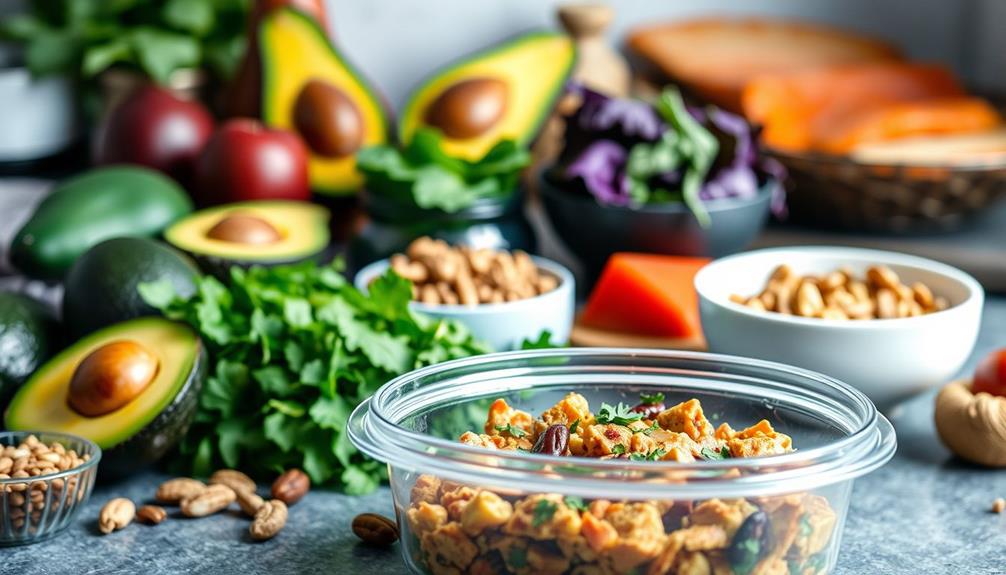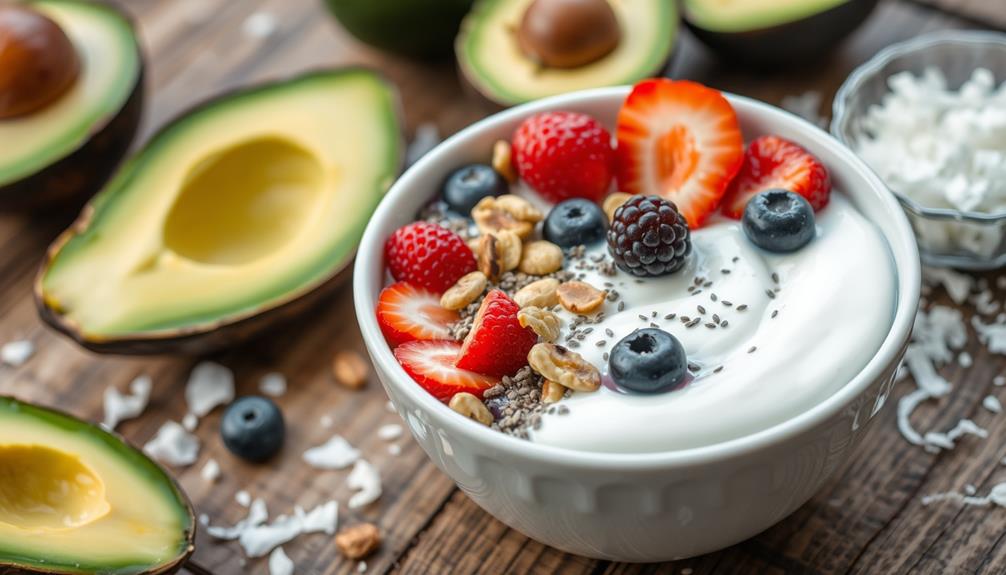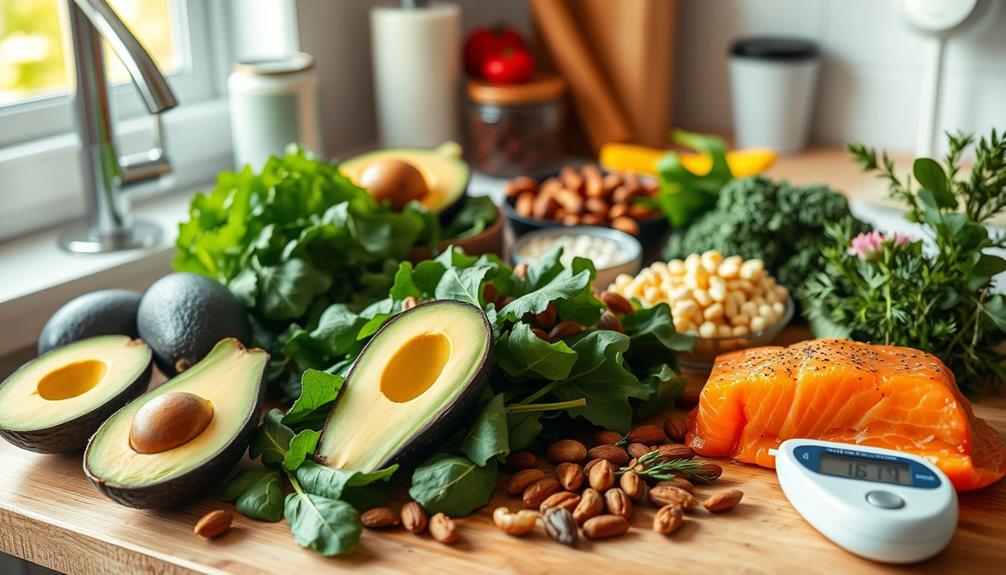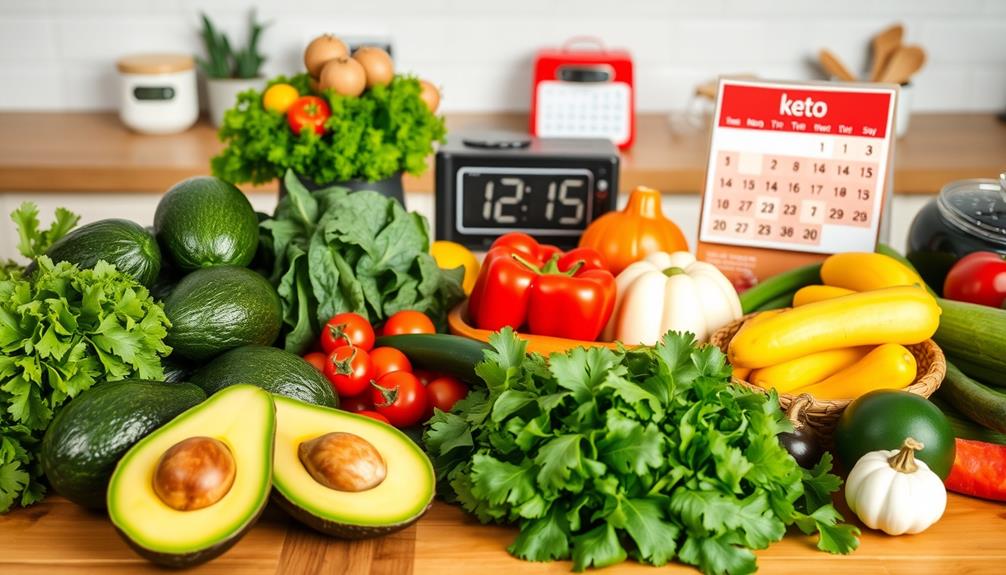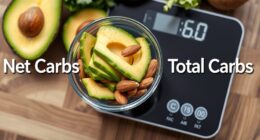To stick to the keto diet, focus on planning and proper food choices. Keep your carb intake between 20-50 grams to maintain ketosis, and prioritize protein-rich and healthy fats like avocados and olive oil. Stay hydrated by drinking plenty of water and managing electrolytes to avoid fatigue. Track your macronutrients with an app to stay accountable and prevent hidden calorie intake. When dining out, research menus ahead and bring keto snacks for social events. Consistent progress monitoring will help you stay motivated, and there's plenty more tips to explore for your keto journey.
Key Takeaways
- Set a daily carb limit of 20-50 grams to maintain ketosis and manage cravings effectively.
- Prioritize meal prep with keto-friendly foods to avoid impulsive eating and ensure adherence.
- Track macronutrient intake using apps to maintain balanced ratios and stay within caloric goals.
- Stay hydrated and monitor electrolytes to prevent fatigue and "keto flu" symptoms during the transition.
- Engage with keto communities for support and motivation, sharing experiences and celebrating progress.
Key Principles of Keto Success

Understanding the key principles of keto success can make your journey much smoother. First and foremost, focus on your calorie intake. Weight loss isn't just about cutting carbs; it's vital to maintain a calorie deficit. Keep track of how many calories you consume to guarantee you're on the right path.
Additionally, being mindful of your hydration levels is essential, as dehydration can lead to fatigue and cravings, particularly in the initial stages of your diet. Juice diets and hydration may provide insights into managing fluid intake effectively.
Next, set a carb limit that aligns with your goals. Typically, this means staying under 20-50 grams of net carbs per day. This restriction helps your body enter ketosis, where it burns fat for fuel.
Tracking macronutrients is equally important. Many people underestimate their food intake, which can stall your progress. Use apps or journals to log what you eat, making sure you're hitting your protein, fat, and carb targets.
Additionally, prioritize protein-dense and fiber-rich foods. These won't only help you feel full but also reduce cravings, making it easier to stick to your plan.
Essential Food Choices
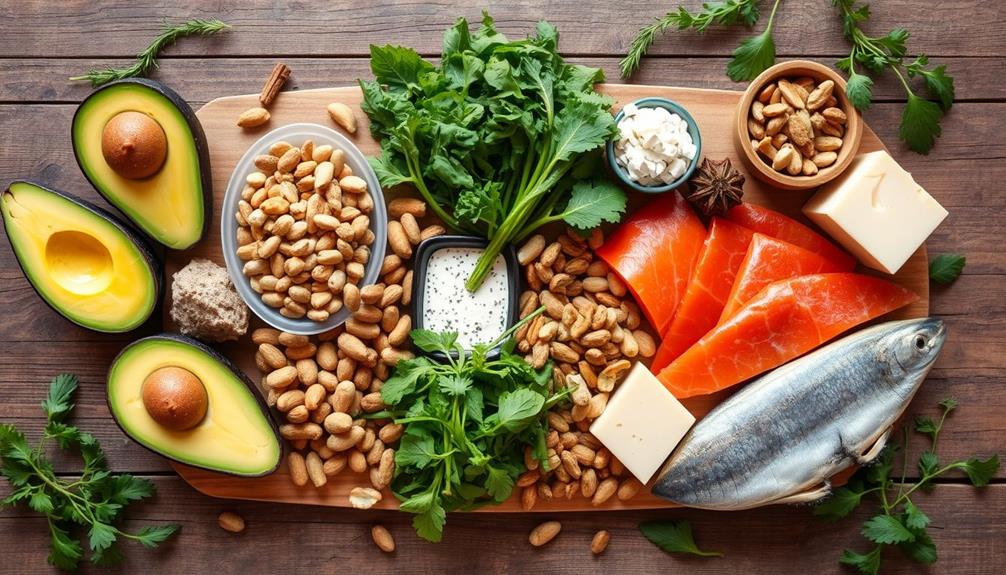
When you're on a keto diet, choosing the right low-carb staples is vital for success. A balanced approach that includes a variety of nutrient-dense foods won't only aid in maintaining ketosis but also support overall health through effective strategies for weight loss.
Planning your meals and keeping keto-friendly snacks handy can help you stay on track and avoid temptation.
Let's explore some essential food choices that will make your journey easier and more enjoyable.
Low-Carb Staples
To successfully navigate the keto diet, stocking up on low-carb staples is essential. Start by filling your pantry with high-quality proteins like beef, pork, poultry, and fatty fish. These foods provide essential amino acids while keeping your carb intake low.
Additionally, consider incorporating foods beneficial for managing gout symptoms as they can complement your overall health while following a keto diet.
Next, incorporate healthy fats into your meals. Avocados, olive oil, coconut oil, and nuts should be your go-to sources, aiming for fats to constitute at least 60% of your daily caloric intake. This not only keeps you in ketosis but also helps you feel full and satisfied.
Don't forget to prioritize non-starchy vegetables like leafy greens, broccoli, and bell peppers. These options are low in carbs, high in fiber, and packed with nutrients, helping you maintain satiety while adhering to a low carb diet.
Avoid high-carb foods like bread, pasta, sugary snacks, and starchy vegetables to keep your total carbs below 35g, ideally below 20g per day.
Meal Prep Strategies
Meal prepping can be a game-changer for sticking to the keto diet, as it allows you to plan high-fat, low-carb meals ahead of time. Start by creating a weekly menu that focuses on meats, non-starchy vegetables, and healthy oils, which will help you adhere to your budget for managing income and expenses. This helps you stay on track and makes grocery shopping easier.
Batch cooking is one of the most effective meal prep strategies. By preparing larger quantities of keto-friendly dishes at once, you'll have quick and convenient options throughout the week.
Keep keto snacks like nuts, cheese, or hard-boiled eggs on hand to manage hunger and curb cravings between meals.
Don't hesitate to explore keto recipe websites or apps for new meal ideas that align with your goals. This variety can make meal prep more enjoyable and less monotonous.
Investing in a food scale and a tracking app is also essential. Accurately measuring your ingredients and monitoring macronutrient intake helps you stay within your carb limits, ensuring you stick to your keto plan.
With these strategies in place, you'll find meal prepping not only simplifies your week but also supports your commitment to the keto lifestyle.
Macro Tracking Importance

Tracking your macros is essential for accurately measuring your calorie intake and ensuring you stay within your keto limits. By keeping an eye on your eating patterns, you can spot triggers that lead to overeating and make necessary adjustments to your macro ratios.
This proactive approach not only supports your weight loss goals but also helps you maintain a balanced diet.
Additionally, just as diversifying your investments with assets like gold can provide stability, Gold IRAs offer potential for long-term capital appreciation and a hedge against economic downturns.
Accurate Calorie Measurement
Accurate calorie measurement plays an essential role in your keto journey, helping you maintain a calorie deficit necessary for weight loss. Underestimating your intake can lead to unexpected weight gain, which is why tracking macronutrients is important. Keeping your daily carb intake below 20g of net carbs allows your body to achieve and sustain nutritional ketosis.
To aid your tracking efforts, consider using calorie tracking apps like MyFitnessPal or Cronometer. These tools can help you identify hidden calories and understand portion sizes.
| Food Item | Calories per Serving |
|---|---|
| Avocado (100g) | 160 |
| Chicken Breast (100g) | 165 |
| Broccoli (100g) | 34 |
| Olive Oil (1 tbsp) | 120 |
Measuring food portions with a scale guarantees precise tracking of macronutrients, as even small inaccuracies can greatly impact your daily carb limits and overall caloric intake. Consistent macro tracking not only helps you stay on track but also allows you to recognize eating patterns and make informed adjustments, essential for overcoming plateaus and achieving long-term weight loss success on keto.
Identify Eating Patterns
Identifying eating patterns is essential for anyone on a keto diet, as it helps you recognize habits that could hinder your progress. Tracking macronutrients is a significant step in this process, as it keeps you within the recommended carb limits of under 35g total carbs and ideally under 20g net carbs per day.
Utilizing calorie tracking apps like MyFitnessPal or Cronometer can help you monitor your food choices accurately while also shedding light on patterns in your eating behavior that may lead to weight gain. Exploring different brewing methods can also help you find low-carb coffee options that align with your keto lifestyle.
Measuring food portions with a food scale guarantees you're precisely tracking macronutrients, which is essential for adhering to keto guidelines. Understanding your personal caloric needs through a keto calculator allows for tailored macro tracking, helping you manage your diet effectively.
Regularly evaluating your food intake can reveal subconscious eating habits that may sabotage your progress. This awareness makes it easier to adjust your strategies to stay on track and achieve your weight loss goals.
Adjusting Macro Ratios
Maintaining the right balance of macronutrients is key to your success on the keto diet. By adjusting macro ratios, you can tailor your intake to meet your individual goals and optimize fat burning. The typical keto ratio is around 70-80% fats, 10-20% protein, and 5-10% carbohydrates, with a critical focus on keeping net carbohydrates below 20g. This is essential for achieving and maintaining nutritional ketosis.
Implementing a holistic SEO approach can also enhance your understanding of how to structure your diet effectively.
Utilizing calorie tracking apps like MyFitnessPal or Cronometer can greatly assist in ensuring accurate macro tracking. These tools help you avoid underestimating your calorie intake, which can hinder your weight loss progress. By regularly measuring and adjusting your macro ratios based on your progress, you can enhance your adherence to the keto diet.
Additionally, monitoring your macronutrient intake allows for better control over hunger and cravings. This makes it easier to stick to the diet and reduces the risk of binge eating, especially when faced with calorically-dense processed foods.
Managing Hydration and Electrolytes

Hydration is essential when you're following a keto diet, as it helps keep your energy levels stable and prevents uncomfortable symptoms. Since low-carb diets can lead to dehydration, it's vital to drink 6-8 glasses of water daily, increasing the amount if you exercise or it's hot outside.
Electrolyte balance is equally important. When you reduce carbs, your body excretes more water and electrolytes, which can lead to the dreaded "keto flu" symptoms like fatigue and headaches. To maintain proper hydration and electrolyte levels, consider incorporating foods and practices that support this balance.
| Electrolyte Source | Benefits |
|---|---|
| Leafy greens | High in magnesium |
| Avocados | Rich in potassium |
| Salted broth | Boosts sodium levels |
| Electrolyte supplements | Quick replenishment |
Adding salt to your meals or sipping on broth can help maintain fluid balance and prevent dehydration during your shift to ketosis. Keep an eye on your hydration levels, especially at the beginning, to avoid dizziness and cravings that could impact your keto journey.
Overcoming Social Challenges

Social gatherings can be a minefield for anyone on a keto diet, but with a little planning, you can navigate them successfully.
Having a strong sense of emotional resilience can empower you to stick to your dietary choices even in challenging situations.
Here are some strategies to help you stick to your low-carb lifestyle while enjoying social events:
- Research restaurant menus in advance for keto-friendly options.
- Communicate your dietary preferences to hosts or waitstaff, ensuring they understand your need for low-carb alternatives.
- Bring keto snacks like nuts, cheese, or veggie sticks to have healthy choices handy.
- Engage with keto communities or friends who share your goals for support and motivation.
- Practice assertiveness by confidently explaining your dietary choices.
Progress Monitoring Strategies

Progress monitoring is critical for anyone on a keto diet, as it helps you stay accountable and make informed adjustments. Start by regularly evaluating your weight and body measurements at least once a week. This routine will help you track progress and adapt your dietary and exercise plans as needed.
Additionally, incorporating essential oils like peppermint oil may enhance your focus and energy levels, supporting your commitment to the diet.
Incorporate progress monitoring strategies like utilizing calorie tracking apps such as MyFitnessPal or Cronometer. These tools guarantee you meet your macronutrient goals and prevent underestimating calorie consumption.
Additionally, keeping a food journal can help identify patterns in your eating habits, cravings, and emotional triggers that might lead to overeating.
Don't forget to measure and record your ketone levels using urine strips or blood meters. This way, you'll confirm whether you're in a state of nutritional ketosis and adjust your carb intake if necessary.
Finally, celebrate non-scale victories, like improved energy levels or better moods, as these can provide motivation beyond just numbers on the scale.
Adapting to Lifestyle Changes

Adjusting to a keto lifestyle can feel challenging, but it doesn't have to be a struggle. Embracing curiosity can enhance your adaptability to new dietary changes, making the process more enjoyable and engaging.
By gradually incorporating keto principles into your routine, you can ease the shift and improve your adherence to the diet. Here are some practical tips to help you adapt:
- Start meal planning: Map out your meals for the week to guarantee you stick to keto-friendly options.
- Batch cook: Prepare meals in advance, so you always have keto recipes ready to go.
- Keep keto snacks handy: Stock up on a variety of snacks to combat cravings and manage hunger during busy days.
- Engage with keto communities: Join support groups or online forums to share experiences and get motivated. This can lead to valuable insights and a sense of belonging, enhancing your overall experience with the diet, as curiosity fosters social connections and relationships.
- Regularly assess your progress: Celebrate non-scale victories like increased energy or improved mood to keep your motivation high.
Frequently Asked Questions
How Do I Stick to Keto?
To stick to your plan, you've got to prepare meals ahead of time, keep snacks handy, track your intake, stay hydrated, and connect with others for support. It makes staying on track so much easier!
Why Is It so Hard to Stick to Keto?
Isn't it tough when cravings hit and energy dips? You struggle with strict carb limits, face social temptations, and can feel overwhelmed by tracking. Without variety, boredom sets in, making commitment even harder.
What Is the Trick to a Keto Diet?
The trick to a keto diet lies in planning. You've got to prepare meals, track your macros, and stay hydrated. Engage with the community for support, and keep your focus on high-fat, low-carb foods.
What Are the 9 Rules of Keto?
You can follow nine essential rules for keto: limit carbs, prioritize healthy fats, monitor protein, stay hydrated, manage electrolytes, plan meals, prep snacks, read labels, and track your progress to maintain your diet effectively.
Conclusion
Sticking to the keto diet can be a rewarding journey when you embrace essential elements. By choosing wholesome foods, counting those critical macros, and staying hydrated, you're setting yourself up for success. Don't let social situations sink your spirit; instead, seek supportive strategies. Monitor your progress and adapt to lifestyle changes with confidence. With dedication and determination, you'll discover a delightful new way of eating that transforms your health and fuels your future. Keep pushing forward! Remember, it’s important to educate yourself on the keto diet basics to fully understand the principles behind it. This knowledge will strengthen your commitment and help you make informed choices about the foods you eat. Additionally, don’t forget to prioritize regular exercise to complement your keto journey and maximize your overall well-being.
